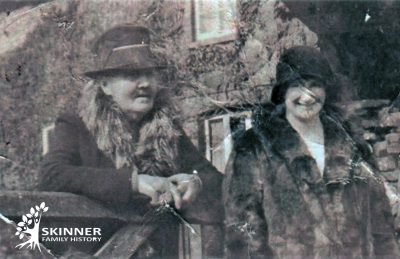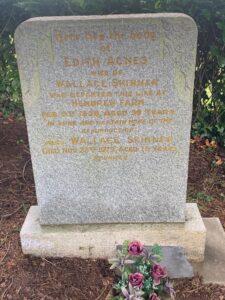Wallace Skinner
renowned dairy farmer

Wallace Skinner was our great-uncle and the first child born to James and Rosa Skinner of Abernant Farm. He was born 9th June 1895 in Kemeys Inferior and was baptised in 1912, along with his six siblings, at All Saint’s Church in the parish.
Wallace was schooled in Caerleon and used to lead his brothers on a 4 mile walk to school and then back home afterwards. Like his brothers he finished school at the earliest opportunity to work alongside his father James on the farm. The work was hard, and Wallace showed an early aptitude and love for the family trade.
In the summer of 1916 Wallace joined the army, enlisting in the 11th Black Watch regiment. He travelled to Scotland for training and was based at Lochend Camp which was situated at Lochend Farm in Bowershall, Dunfermline, Fife. Wallace earned the status of marksman after passing his musketry course with high scores and became an army instructor. Wallace earned stripes in the army and became a Corporal serving in the 38th Battalion Training Reserves based in Dunfermline.
In letters to his uncle John, Wallace described his life in the army, he wrote about being stationed near the family home of Falkland and how proud he was of his Scottish lineage. Wallace also mentioned that work in the army was less demanding than he had known as a farmer’s son! Wallace spent most of the war years training new recruits but was drafted to France for a short period.


In November 1923, 28-year-old Wallace set sail from Liverpool to New Zealand, travelling on the Suffolk with a 3rd class ticket. The war had tightened bonds between Britain and its empire and led to a revival of assisted emigration to countries including New Zealand. The British government assisted migration with the Empire Settlement Act 1922. Through this scheme New Zealanders could nominate anyone for whom they could provide a job and accommodation.
Labour for farms was a particular need and the New Zealand government agreed to boost the British subsidies. Between 1921 and 1927, 1,400 young men arrived from the UK to work on farms. Wallace took advantage of the subsidies and travelled to Wellington with plans to work towards a farm of his own. Wallace spent almost six years in New Zealand as a farm worker. Whilst overseas Wallace had become engaged to Edith Goad who was back in Wales. His decision to quit New Zealand and return home in March 1928 was taken because Edith wouldn’t emigrate.
On his return Wallace stayed at Abernant and spent time with Edith, but he wasn’t home for long. On 5th November 1928 Wallace sailed to Sydney and spent four months there, sailing back to London in March 1929. Just three months later Wallace, who was then 34, and Edith, 31, married. Edith was from nearby Hendrew Farm where she lived with her parents, farmer Frank Goad and his wife Elizabeth. Frank, ready for retirement, had been advertising the farm to let, and the animals, machinery, and furniture for sale. The lot included 11 dairy cows, 35 ewes, 4 working horses and 13 pigs.
The marriage of Wallace and Edith changed Frank’s plans and his new son-in-law took the farm on. This allowed Frank and his wife to move to another property on the farm, Hendrew Villa, and retire. The newlyweds settled at Hendrew Farm and in 1933 Wallace’s mother Rosa, who was now a widow, joined them at the farm. Rosa was 66 and spent her later years living with Wallace and Edith.


In 1934 the household grew again when Edith gave birth to Andrew. Three more children followed – John, Mary and Betty. On the 1939 Register Wallace is listed as Master Farmer and Heavy Worker. The register shows us a household of seven at Hendrew Farm: Wallace and Edith, three children, Rosa, and Paul Lynch, a young Cowman.
Wallace earned himself a reputation as a strict and somewhat unyielding man with strong opinions, traits similar to those of his grandfather John. Wallace played a key role in Skinner life, providing a home to brother Reg and his family for two years during a return from America, and also hosting his sister Margaret when she made visits from South Africa. In 1950 Wallace travelled to Stutterheim in South Africa to support his sister, when Margaret’s son John Haynes, was baptised.
Wallace was a committed and disciplined dairy farmer, who was renowned for the quality of his herd. He was particularly recognised for his pedigree Red Polls some of which were purchased for shipment to Colombia for breeding. He served as a Chair of the Monmouthshire and Brecon Milk Recording Society and was a bronze medal winner in their annual competition.
In 1944 an incensed Wallace had a letter printed in the Western Daily Press. He had taken issue with a previous article that had suggested a butter-fat deficiencies in Red Poll cows. Wallace mounted a spirited defence of his favoured herd quoting statistics from his own farm. The letter was printed in full.


Edith passed away in 1958 and was buried at their local church. Wallace remained at Hendrew Farm and continued to work. His children and their partners lived locally and were a great support. In 1971 Wallace received a visit from James Skinner, an American cousin, who spent most of the day with him and left this account of his visit:
“What a character! He had been savaged by a bull sometime earlier and was not in good health, but we spent one cold afternoon sitting in front of a coal fireplace while Wallace gave me his views on the rest of the family and the world in general. Wallace had very strong opinions. His daughter Betty and her husband took care of the farm and cattle and later gave me the tour. They were sweet and special people.”
Wallace spent his remaining years at the farm until his death in 1973. He had spent more than 40 years at Hendrew. Wallace was a farmer until the end, and his dairy herd was then sold at auction. Wallace and Edith are buried together at their local church, St Peter’s in Llandevaud, a ten minute walk from the farm. Wallace was survived by his four children to whom he left his estate. The farm still exists today, the buildings and land sit on Hendrew Lane.
If you would to add anything to the story of Wallace and Edith please email: research@skinnerfamilyhistory.com

